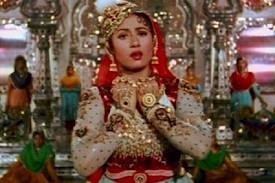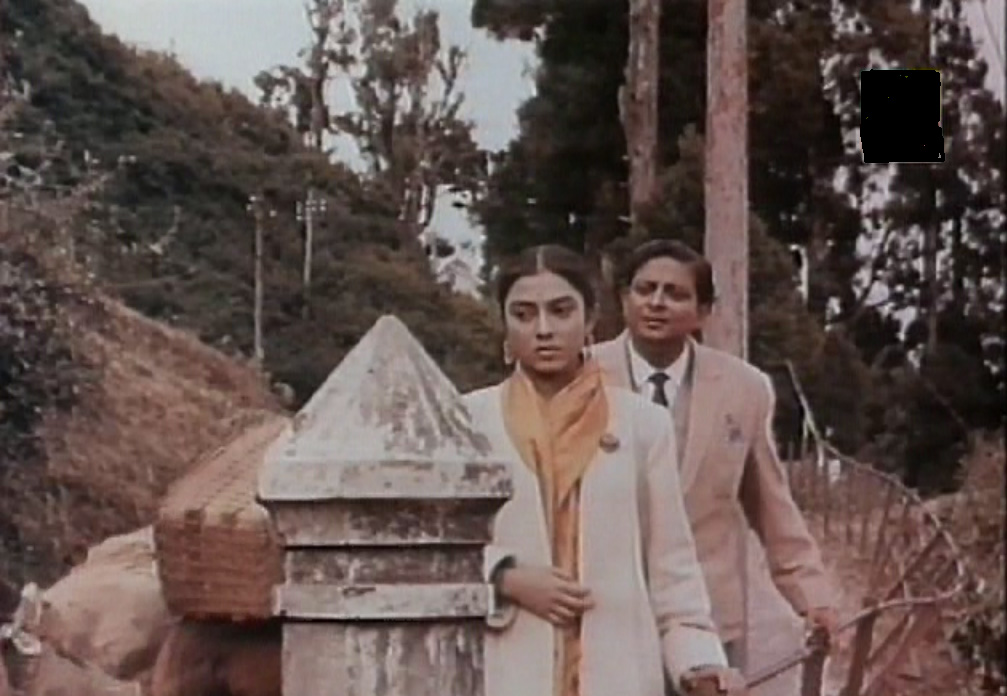Indian cinema: 1960-69
Readers can send additional information, corrections, photographs and even
complete articles on new subjects to our Facebook page Indpaedia.com. If found suitable, this additional information will be incorporated into the Indpaedia article (with an acknowledgement) and new entries will be created (also with due acknowledgement). Readers will be able to edit existing articles and post new articles directly on Indpaedia.com only after its formal launch. |
Contents |
Indian cinema: 1960-69
Title and authorship of the original article(s)
|
Brief history of Indian cinema By UrooJ, aligarians.com, mid-2000 |
Bollywood Cinema By h2g2, mid-2000 |
The Swinging 60s of Indian Films By indianetzone, mid-2000 |
This is an article selected for the excellence of its content. |
1960 by Urooj

1960 : Film Finance Corporation (FFC) formed with authorized capital of Rs 1 crore. The Government of India acquires Prabhat Studios to set up The Film Institute of India. The Institute for Film Technology is started in Madras. The Hindustan Photo Film manufacturing Co. starts making B&W X-ray film. Ranadheera Kanteerava is the first big Kannada hit establishing its star, Rajkumar. K.Asif’s Mughal-e-Azam hits the screen after almost 10 years in the making and is a resounding success. Gandhian Sarvodaya workers start a series of protests against indecent film posters and hoardings. The weekly tabloid Movieland is launched in Madras.
1961 : Mrinal Sen’s Baishey Sravan shown at National Film Theatre in London draws great critical acclaim. First Rajasthani film, Babasa Ri Laadi.
1962 : Second International Film Festival is held in New Delhi. Ray makes his first film in colour, Kanchenjunga. Pakistan bans Indian films in East Pakistan hitting the Bengali Cinema pretty hard. Indian Film Culture, the journal of the Federation of Film Societies of India is launched in Calcutta.
1963 : Indian Film Industry celebrates its golden jubilee. The Indian Motion Picture Export Corporation (IMPEC) is formed. The first Indian Merchant-Ivory Film, The Householder. Barnouw and Krishnaswamy’s Indian Film is published. The Journal of the CTA of South India, a Madras based monthly is started. It is probably the first technical film journal in India and reports on the work of major technicians in the South.
1963: Lava-Kusa (1963/ Telugu)
Cast: NTR, Anjali Devi, Nagaiah, Kantharao, Ramana Reddy, Master Nagaraju, Master Subrahmanyam, Kannamba, Suryakantham, Relangi, Girija, S Varalakshmi and Others.
Action: Shyamasunder.
Art: TVS Sharma.
Choreography: Vempati Satyam.
Cinematography: PL Roy.
Costumes: B Narayana Murthy, B Apparao, K Srirama Murthy & MV Raju.
Editing: A Sanjeevi.
Lyrics: Samudrala, Kosaraju & Sadasiva Brahmam.
Makeup: Haribabu, Peetambaram, Bhaktavatsalam, Krishna & Sudhakar.
Music: Ghantasala.
Playback Singers: Ghantasala, Madhavapeddi, Pitapuram Nageswara Rao, Susheela, Leela, Jikki, Rani, Komala, Janaki, Vaidehi, Raghavulu & Mallik.
Story: Sadasiva Brahmam.
Screenplay & Direction: C Pullaiah & CS Rao.
Producer: A Shankara Reddy. Banner: Lalitha Sivajyothi Films.
Release Year: 1963.
NTR Anjali Devi Kantha Rao
The story of the post-Sri Rama coronation (pattabhishekam), well known as 'Uttara Ramayanam', moves around the twins born to Sri Rama and Sita, during her exile. Sri Rama sends Sita to forests, basing on a comment made by a washerman. Sita gives birth to twins Lava and Kusa. They learn from Valmiki how great was Sri Rama and then sing his story as a ballad. Later they confront him, his brothers and Anjaneya as a result of halting the horse sent by Sri Rama as part of his Aswamedha Yagam. It ends with the union of Rama with his twin sons, but he gets separated from his wife Sita, who enters into her mother - earth.
Devaki Bose in Bengal made the first ever-Indian film on this subject, with Prithviraj Kapoor playing Sri Rama. This was made under the banner of East India Film Company. This was based on a stage play that was popular by then. C Pullaiah who was also working there was attracted to this subject. The Film Company wanted Pullaiah to make this in Telugu. The script is same for both. Set material like chariots and costumes are same. Balijepalli wrote the script in Telugu. He thought of employing a new actor who carries some feminine charm, as a sloka in Ramayana described Sri Rama so. They scanned the Telugu theatre and found Parupalli Subba Rao, playing Radha in the stage play 'Radha-Krishna'. Sriranjani (Senior) was chosen to play Sita. They also scanned for artistes to play the three brothers of Sri Rama, having features a bit nearer to Parupalli, to give an impression that they were all born to one father. This was all 1934 story. The film was a hit.
Master Nagaraju Master Subrahmanyam Nagaiah
Then the same subject was again made in Geva color 24 years later, in 1958, by Lalitha Sivajyothi's A Shankara Reddy. But Modern Theatres' Tamil film 'Alibaba and forty thieves' was the first South Indian film in Geva color. Telugu cinema was behind in this aspect. Better late than never was the moto of Shankara Reddy and decided to make this in Geva color. Lava–Kusa is recorded today as the first color film in Telugu film history. NT Rama Rao as Rama, Anjali Devi as Sita, Nagaiah as Valmiki suited most to these roles. Sadasiva Brahmam was the dialogue writer and Ghantasala took charge of composing music. Samudrala and Kosaraju penned songs. 'Jayamu Jayamu', 'Ye Nimushaniki Yemi Jaruguno' and 'Ramanna Ramudu Kodanda Ramudu' were Kosaraju's lyrics that won popularity overnight. Ghantasala's music score is one of his best efforts. It earned the admiration of Nagaiah, who was listening to these songs in the office of Shankara Reddy. It is said that he predicted that this film would be a great hit.
Vauhini Studios was the choice to make this magnum opus. There was a big garden in Ramavaram, opposite MGR's house, where the set of Valmiki Ashram was laid. The film was made in Telugu and Tamil languages simultaneously. NTR, Anjali Devi and Nagaiah figured in both the versions. The script too is the same except that Telugu film has many verses. However, the film was to be halted suddenly because of early commitments of the artistes to play in other films.
The production of Lava-Kusa was postponed, for almost four years, after the completion of eight thousand feet edited version. Another twelve thousand feet film was yet to be shot. The sequences set in the Ashram was completed. But Sri Rama's scenes in the huge palace were pending. The climax was also due. Producer Shankara Reddy got into financial troubles. He was upset. But he was a man of courage and wanted to complete this project.
By the time he could collect the needed money to re-launch the production, another problem arose. Director Pullaiah fell sick. He could not even move. Who would complete this film was the big question. Sundarlal Nahata, its distributor suggested the name of Pullaiah's son CS Rao. The latter met BN Reddy who was planning to make a film on the subject of Sita. CS Rao requested him to take up the making of the remaining part of Lava-Kusa. BN politely refused and advised CS Rao to continue the work of his father, as 'the film belongs to you and to your father, you will succeed'. Rao completed the film, which became a history in Telugu cinema.
But this gap of nearly five years made some artistes look old – especially the boys who played Lava and Kusa. You wont miss that when you watch them taller in some scenes and shorter in other scenes. The Tamil version faced a different kind of problem. Lava's role was given to a girl. By the time the film was restarted, she grew into a young woman. Therefore Lava cannot be shown bare-bodied any more. These characters of the twins in Telugu are shown just wearing a small cloth covering their shoulders. But in Tamil, the cloth was replaced with deer's skin on the shoulders of both Lava and Kusa. It was released in the year 1963. The great effort and the relentless struggle of the producer Shankara Reddy and CS Rao's skillful handling on the footsteps of his father bore fruit. The film was a great hit.
1964 : National Film Archive of India set up in Pune. The Film Institute at Adyar, Madras starts. First Indian film shot extensively abroad - Raj Kapoor’s Sangam. Report on Indian Cinema for UNESCO by Jerzy Toeplitz, President of FIAF. First Kashmiri Film Naizraat. Death of Guru Dutt.
1965 : The International Film Festival of India turns competitive.The patriotic fervour started by Haqeeqat (1964) continues with Shaheed (1965).
1966 : Dev Anand’s Company Navketan produces jointly with Pearl Buck an American version of Guide based on R.K. Narayan’s novel and directed by Ted Danielowski. Ramu Kariat’s Chemmeen wins the President’s Gold Medal as Best Feature of 1965, the first Malayalam Film to win the honour. Ritwik Ghatak joins the Film Institute of India. Karnataka initiates a scheme to subsidize all films made in the State. The initial subsidy is Rs 50,000 for a B&W and Rs 1,00,000 for a colour film. The first film in Dogri, Kumar Kuldip’s Gallan Hoyian Beetiyan.
1967 : Hindustan Photo Films makes India self sufficient in B&W and sound negative film. Around the World, first 70mm Indian Film.CinemaScope and 70mm films Start of the Bengali film Monthly Chitrabikshan. M.G. Ramachandran is shot at and injured by co-star M.R. Radha. The Vividh Bharati Channel on All-India Radio goes commercial in Bombay, Pune and Nagpur.
1968 : Month long retrospective of Indian Films organized by B.D. Garga opens at Palais de Chaillot, Cinamatheque Francaise. Bombay Cinema Houses close in protest against Maharshtra State taxation policy. The Khosla Committee submits report on censorship to the Government. K.A. Abbas’s Char Shaher Ek kahani sparks a major censorship controversy. A manifesto for New Indian Cinema is issued by Mrinal Sen and Arun Kaul, advocating a state sponsored author-cinema. The State owned Jyoti-Chitraban studio is inaugurated in Kahilipara, Guwahati, Assam.
1969 : Mrinal Sen’s Bhuvan Shome in Hindi becomes a trendsetter for low budget offbeat films. In the wake of its commercial success FFC declares its policy to back low budget offbeat films. Uski Roti directed by Mani Kaul also produced by the FFC. Aradhana makes Rajesh Khanna a megastar. Publication of P.Parrains’s Regards sur le cinema indien in Paris. First Satyajit Ray retrospective held at the Cinematheque, Paris. Deaths of S.S. Vasan and Ardheshir Irani.
Hindi-Urdu cinema: 1960-69
See Hindi-Urdu cinema: 1960-69 for
a)the 50 biggest hits of the 1960s (list);
b)the 20-odd biggest hits of each year (list);
c) Comments about some of the bigger stars and films of the 1960s.
See also
CinemaScope films in Bangladesh, India, Nepal, Pakistan, Sri Lanka 70mm films in India/ South Asia Cinerama theatres in India, Pakistan, Sri Lanka 3D films in South Asia Colour films in South Asia Colour films in India Colour films in Hindi-Urdu
Indian cinema: historical outline Covers the era before the first Indian feature filmIndian cinema: 1913-20 Indian cinema: 1920-29 Indian cinema: 1930-39 Indian cinema: 1940-49 Indian cinema: 1950-59 Indian cinema: 1960-69 Indian cinema: 1970-79 Indian cinema: 1980-89 Indian cinema: 1990-99 Indian cinema: 2000-09 Indian cinema: 2010-19


